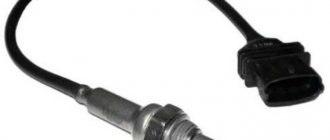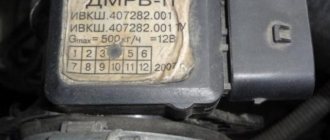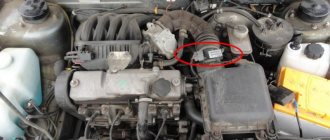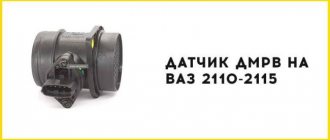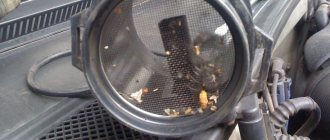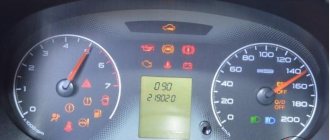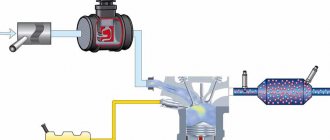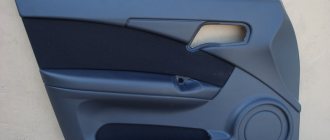Professional MAF cleaners allow you to clean and restore the functionality of the mass air flow sensor and air pressure sensor without damaging the sensitive element itself. When choosing a non-special cleaning agent, it is necessary to take into account its composition, since the air sensor itself is very susceptible to destruction by chemically aggressive substances.
Of all the products on the market specifically designed to remove carbon deposits from the MAF, DTVV or DDVK sensors, five cleaners turned out to be the most popular and effective. The results of their action have been proven in practical use by many car owners. The rating of air flow sensor cleaners was compiled according to reviews. To make the right choice, study in detail their characteristics, composition and indications for use.
| Name of the air flow sensor cleaner | Features of the product | Volume in ml | Price as of summer 2022, Russian rubles |
| Liqui Moly Luftmassensor Reiniger | Removes stubborn stains and evaporates quickly | 200 | 950 |
| Kerry KR-909-1 | Good performance at an affordable price | 210 | 160 |
| Hi Gear Mass Air Flow Sensor Cleaner | Used for professional cleaning in car services | 284 | 640 |
| CRC Air Sensor Clean PRO | A good option for cleaning diesel car sensors | 250 | 730 |
| Gunk Mass Air Flow Sensor Cleaner | Can be used for MAF and IAT sensors; if heavily soiled, it will have to be reused. Has a rubber seal | 170 | 500 |
Compound
Designed to effectively remove oil, dirt, small fabric fibers and dust from the sensor without damaging it. The main components of MAF sensor cleaners are:
- Hexane, or its rapidly evaporating derivatives.
- An alcohol-based solvent (usually 91 percent isopropyl alcohol).
- Special additives that manufacturers (the main one is the Liqui Moly trademark) use to protect their copyrights. They mainly affect smell and density.
- Carbon dioxide as a retardant for the composition in a can.
The mixture is usually sold in the form of an aerosol, so the substances must be highly dispersed, not irritate the skin and not have a harmful effect on the environment. The physical and mechanical characteristics of the most commonly used compounds (for example, Luftmassensensor-Reiniger from Liqui Moli) are:
- Density, kg/m 3 - 680...720.
- Acid number – 27…29.
- Ignition temperature, º C – not less than 250.
How to use?
Cleaning the air flow sensor must be performed whenever the air filters are changed. The sensor itself is located in the air channel between the filter box and the throttle body. Using a special tool, the device is carefully disconnected from the electrical connectors.
Some brands of cars are equipped with mechanical flow meters. They do not have measuring wires, and therefore are less sensitive to the thoroughness of dismantling.
Next, 10 to 15 sprays are applied onto the wire or sensor plate. The composition is applied to all sides of the sensor, including terminals and connectors. Platinum wires are very thin, so they cannot be wiped. After the composition has completely dried, the device can be returned to its original place. A good spray should not leave marks or streaks on the surface of the air flow sensor.
Features of application
The nuances are determined by the brand of car that has a mass air flow sensor. In particular, the choice of installation tools used to unscrew the fasteners depends on this.
You should never use MAF cleaner while the engine is running or the ignition is on. This can cause serious damage to the sensor, so it should only be disconnected when there is no current in the system.
Before spraying, place the sensor on a clean towel. Cleaning must be done so as not to touch any of the sensitive elements with the nozzle of the aerosol head.
To improve the cleaning effect, it is recommended to pre-wash the surface of the air flow sensor. To do this, place the unit in a plastic bag filled with isopropyl alcohol and shake vigorously several times. After drying, apply mass air flow sensor cleaner.
Is it possible to clean the air flow sensor with carburetor cleaner?
It is not recommended to use carburetor cleaners for electronic sensors! The chemicals contained in these products can cause irreversible damage to sensitive elements. However, the use of such compositions for cleaning mechanical flow meters is not excluded. However, here too it is better to use specialized substances, for example, budget cleaners offered by the Kerry brand.
It is necessary to warn owners of cars equipped with similar sensors against other errors:
- Cleaning with more active solvents: this may cause deformation of the plastic parts of the sensor itself and its housing.
- Using cleaner brands not recommended by the vehicle manufacturer.
- Cleaning the mass air flow sensor with products that are used to clean the throttle body.
- Reinstall the unit that has not dried after treatment.
A clean sensor can restore 4 to 10 horsepower to the car, which is well worth the time and expense of cleaning. It is recommended to perform such prevention once a year.
When the first signs of a malfunction occur, you should definitely check the mass air flow sensor, and then, depending on the situation, clean or replace the device.
Examination
Now let's talk about how to check our sensor. Today, two main methods of checking the mass air flow sensor are used.
- The engine is tested in operation with the mass air flow sensor disconnected. Simply turn off the power from the regulator and start the motor. When the mass air flow sensor is not present during startup, the electronic control unit turns on the power unit in emergency mode. The speed is adjusted to 1500 rpm. After disconnecting the sensor, drive a few kilometers and evaluate the dynamics and power. If the engine is running normally, then the sensor is the cause of the symptoms.
What is a mass air flow sensor, why is it important and how to diagnose its malfunction
Over the past three decades, engines with distributed and direct fuel injection have finally supplanted all other types of designs. It would seem that this is a considerable period of time, but engineers have not been able to overcome the “childhood diseases” of important electronic components, including the mass air flow sensor (MAF), which is responsible for the composition of the air-fuel mixture. Let's remember how the mass air flow sensor works, why it is so important and how to diagnose its malfunction.
What is DMRV
Modern engines use two types of power supply systems: with distributed injection, the nozzle supplies fuel to the intake pipe, with direct injection, it supplies fuel to the combustion chamber. For both systems, the correct operation of the mass air flow sensor, which was once mechanical (vane type), but is now devoid of moving mechanical parts and made hot-wire (from “anemo” - wind), is important.
Factory air flow sensor made in Germany for a VAZ engine
The mass air flow sensor can be installed not only on a gasoline engine, but also on a diesel engine, where the operation of the EGR valve (exhaust gas recirculation system) is “tied” to it.
As old-school drivers used to say, an internal combustion engine does not work in two cases: there is nothing to burn or there is nothing to set it on fire. The mass air flow sensor precisely informs the electronic control unit about the amount of incoming air, the oxygen of which becomes the “fuel” for the working mixture. Having received such a signal, the ECU can ensure the most complete combustion possible. The device, located in the intake tract, consists of two resistors, which can be designed in various designs. In the first case, the resistor is exposed to passing air: when the flow intensity changes, it cools and its internal resistance changes. In the second case, it is not blown - based on the difference in readings from two resistors, the volume of air that needs to be supplied to the cylinders is calculated.
The sensor is supplied to the aftermarket with protective caps to prevent contamination during transportation.
This is what the sensor looks like on a regular VAZ engine. It will not be possible to remove it from the case without a special key.
The removed sensor is in its “bare” state. The sensitive element is clearly visible
Based on the data on the mass and temperature of the incoming air, the ECU determines its density, and also calculates the duration of opening of the injectors and the amount of fuel supplied to the combustion chamber. In general, the mass air flow sensor is important for achieving maximum engine power, for more complete combustion (environmentally friendly), and for economical driving. The failure of this sensor, like most others, causes the Check Engine warning light to go off.
The check engine light can come on for any reason. If there is no on-board computer with a diagnostic function, you will have to go to a service station where there is a scanner
However, the owner does not always associate the triggered “check” with the mass air flow sensor - especially if the engine runs without any interruptions, and the dynamic characteristics of the car have not deteriorated at all. Therefore, it is important not to leave the illuminated engine malfunction indicator unattended, but to consider errors with the diagnostic computer.
MAF or DBP?
The absolute pressure sensor (MAP), together with the temperature sensor (DTS), also controls how much air enters the intake manifold. Based on these readings, the controller generates a pulse command to the injectors. An important difference between DBP and MAF is the absence of air in the housing, since this sensor works based on measuring the difference in inlet pressure and pressure in the vacuum chamber. A design feature of the DBP is a highly sensitive diaphragm, which expands under the influence of pressure in the intake manifold. This process affects the resistance of the strain gauges, as a result of which the voltage changes.
The absolute pressure sensor (pictured) and the mass air flow sensor operate on different principles
DBP is much cheaper than a mass air flow sensor, but its operating algorithm is less advanced. And in general, not all control units can work correctly with DBP. Moreover, when switching to an absolute pressure sensor, the engine may respond to opening the throttle with a much greater delay than with the original mass air flow sensor. And, of course, simply replacing the mass air flow sensor with a DBP without serious modifications will not work due to the difference in their design and even location.
There are engines where there is no choice between DBP and MAF, because both of these sensors are present on the engine at once!
Usually, thoughts about installing a DBP instead of a standard mass air flow sensor appear when the latter fails, as well as during engine tuning - especially if the aspirated system is converted to turbocharging. However, some owners deliberately refuse the mass air flow sensor because of its high cost and not the greatest resource. Indeed, in an unfortunate combination of circumstances, the sensor can fail after 60-70 thousand kilometers, and by the figure of 120-130 thousand on the odometer of many budget cars, it is almost guaranteed to “die”.
Cleaning
Quite often you can avoid replacing the mass air flow sensor by simply cleaning this engine element.
You should do the cleaning yourself in this way:
- Remove the pipe from the mass air flow sensor;
- Now remove the sensor from the pipe. Otherwise, high-quality washing will not work;
- To remove the sensor, arm yourself with sprocket keys in advance. Finding such kits is not a problem;
- Unscrew all the fasteners, remove the sensor from the pipe and assess its external condition;
- Often there are traces of oil deposits on the sensor. The purpose of cleaning is to make the device as good as new;
- Carburetor cleaner is often used to clean the air flow sensor;
- Inside the film there are sensors, which are small wires attached to a special resin. These elements must be carefully sprayed with cleaner so as not to damage the devices;
- Wait a while for the surfaces to dry. To speed up the process, use a can of compressed air;
- It is not uncommon to use alcohol instead of carburetor cleaner, which also works quite effectively;
- Proper cleaning of the mass air flow sensor involves treating the pipes from accumulated debris, dirt and dust;
- Having carefully processed all the components of the removed mass air flow sensor, wait until it dries, and then reassemble it. Cleaning is complete.
Spray cleaning
Statistics show that in about 80% of cases, simple cleaning can return the mass air flow sensor to its previous functionality.
Price issue
80% is not 100. Therefore, sometimes you have to change the sensor. And to replace it, you need to buy it.
There are three price categories for air mass flow sensors:
- Cheap. These are predominantly Chinese products, the price of which is up to 1000 rubles. It is strongly not recommended to purchase such regulators;
- Average. These include sensors from AvtoVAZ, domestic and some foreign analogues. These cost from 1500 to 2500 rubles;
- Expensive. High-quality, reliable, imported air flow sensors, the price of which can reach 5.5 thousand rubles. It’s hard to say how rational it is to buy them. But they will definitely last a long time.
When choosing a new mass air flow sensor, focus not only on the price, but also on the manufacturer. Today, the most popular devices are from Siemens and Bosch. Average in price, excellent in quality.
Instructions for washing the mass air flow sensor
Cleaning the flow meter can be done in a garage; there is nothing complicated about it.
Depending on the car model, the procedure for removing the sensor can be carried out in different ways; consider an example of cleaning with a domestic “Ten”:
- First, you should turn off the ignition and, just in case, reset the battery terminal. Open the hood and find the mass air flow sensor, then disconnect the connector from it. There is a pipe connected to the flow meter; it must be disconnected. Using a wrench, you need to unscrew the screw that secures the device to the air filter, or rather, to its housing.
- The flow meter itself is removed from the corrugation; in the case of the “ten”, an asterisk wrench is required to dismantle the sensor. Use it to unscrew the screws and then remove the device from the seat.
- If, after removal, you notice that there is an oil deposit on the device, you will need to rid the case of this. Any product from those described above is suitable for cleansing. As practice shows, there is no fundamental difference between these means.
- On the sensitive element, usually made in the form of a film, there are several controllers; they are made in the form of a wire and mounted on resin. Using the same cleaning agent, you will need to carefully, not in abundance, spray it on the sensitive element. At this stage, you should act as carefully as possible, since there is a possibility of damage to the film. After the sensitive part has been treated, you need to wait a little until the product takes effect. If there is a lot of contamination, then it may make sense to repeat this procedure once or twice. In order to ensure faster evaporation of the substance, you can use a pump or compressor device. But keep in mind that too much pressure can destroy the sensitive component, so don't overdo it.
Photo gallery “How to clean yourself”
Price issue
The cost of Liqui Moly cleanser is currently about 700 rubles. A cheaper analogue, liquid for cleaning carburetors, will cost the buyer about 70-100 rubles. As for WD-40, the cost of a 100 ml can today will be approximately 180-220 rubles.
Replacement
It is not difficult to replace the mass air flow sensor with your own hands, even if you do not have any special skills in car repair. Having checked the condition of the device and determined that cleaning will not help, all that remains is to replace it.
- Place the car on a level surface, lift the hood and remove the negative terminal from the battery.
- Disconnect the sensor connector. We have already talked about its location, so there will be no problems with the search.
- Using a screwdriver, remove the clamping bolt of the clamp that secures the corrugation to the mass air flow sensor.
- The corrugation is removed.
- Using a 10mm wrench, unscrew the two bolts that hold the sensor to the air filter housing.
- After removing the failed oxygen sensor, install a new regulator in its place.
- Screw back a couple of bolts, secure the corrugation and secure it with a clamp.
- Reconnect the connector and return the negative terminal to the battery.
If everything is done correctly and the breakdown is correctly identified, then the engine will return to its previous performance and the error signal on the dashboard will disappear.
Replacing the device
To finally check the result of the repair, go out onto the road, do a test drive and be sure to try to press the gas pedal sharply. If the dynamics and power become the same as before the problems arose, you did everything correctly, and it was the mass air flow sensor that was the culprit of the malfunction.
Every vehicle owner who takes good care of his car and is interested in it knows very well what a mass air flow sensor, or MAF, is. Also, many car enthusiasts know what functions this device performs. At the same time, not every driver knows how to clean the mass air flow sensor. What exactly is this detail and what is its role? This question is relevant for many beginners.
Features, diagnostics and replacement of elements of injection systems on VAZ cars
Below we will look at the main controllers!
Hall
There are several options for how you can check the Hall sensor of a VAZ:
- Use a known working device for diagnostics and install it instead of the standard one. If after replacement the problems in engine operation cease, this indicates a malfunction of the regulator.
- Using a tester, diagnose the controller voltage at its terminals. During normal operation of the device, the voltage should be from 0.4 to 11 volts.
The replacement procedure is performed as follows (the process is described using the example of model 2107):
- First, the switchgear is dismantled and its cover is unscrewed.
- Then the slider is dismantled; to do this, you need to pull it up a little.
- Remove the cover and unscrew the bolt that secures the plug.
- You will also need to unscrew the bolts that secure the controller plate. After this, the screws that secure the vacuum corrector are unscrewed.
- Next, the retaining ring is dismantled and the rod is removed along with the corrector itself.
- To disconnect the wires, you will need to move the clamps apart.
- The support plate is pulled out, after which several bolts are unscrewed and the manufacturer dismantles the controller. A new controller is being installed, assembly is carried out in the reverse order (the author of the video is Andrey Gryaznov).
Speeds
The following symptoms may indicate a failure of this regulator:
- at idle, the speed of the power unit floats, if the driver does not press on the gas, this can lead to an arbitrary shutdown of the engine;
- the speedometer needle readings float, the device may not work as a whole;
- fuel consumption has increased;
- the power of the power unit has decreased.
The controller itself is located on the gearbox. To replace it, you only need to jack up the wheel, disconnect the power wires and remove the regulator.
Fuel level
The VAZ or FLS fuel level sensor is used to indicate the remaining volume of gasoline in the fuel tank. Moreover, the fuel level sensor itself is installed in the same housing with the fuel pump. If it malfunctions, the readings on the dashboard may be inaccurate.
The replacement is done like this (using the example of model 2110):
- The battery is disconnected and the rear seat of the car is removed. Using a Phillips screwdriver, unscrew the bolts that secure the fuel pump hatch and remove the cover.
- After this, all wires leading to it are disconnected from the connector. It is also necessary to disconnect all the pipes that are supplied to the fuel pump.
- Then the nuts securing the clamping ring are unscrewed. If the nuts are rusty, treat them with WD-40 before unscrewing.
- Having done this, unscrew the bolts that directly secure the fuel level sensor itself. The guides are pulled out from the pump casing, and the fasteners need to be bent with a screwdriver.
- At the final stage, the cover is dismantled, after which you will be able to gain access to the FLS. The controller is replaced, the pump and other elements are assembled in the reverse order of removal.
Idle move
If the idle speed sensor on a VAZ fails, this is fraught with the following problems:
- floating speed, in particular, when additional voltage consumers are turned on - optics, heater, audio system, etc.;
- the engine will start to stall;
- when the central gear is activated, the engine may stall;
- in some cases, failure of the IAC can lead to body vibrations;
- the appearance of a Check indicator on the dashboard, but it does not light up in all cases.
When is it time to clean?
But regardless of the type of sensor, over time it begins to function incorrectly due to contamination - the platinum measuring elements become covered with dust. Therefore, the question of how to clean the mass air flow sensor will always be relevant.
Why does this happen? The main reason for sensor contamination lies on the surface - the unsatisfactory condition of the air filter. If the filter element is of poor build quality, then it is not able to trap microscopic particles of dirt and dust that settle on the sensing element of the mass flow sensor.
As a result, the device is not able to accurately measure the amount of air and sends incorrect data to the ECU. It's not hard to imagine what this might lead to. Here we gradually approach some characteristic signs that may indicate that the sensor is clogged and needs to be cleaned:
- The need to clean the mass air flow sensor on a VAZ or other cars arises when the engine idles intermittently, in some cases they are too high - up to 1500.
- The car may jerk and have difficulty accelerating.
- Sometimes the engine does not start at all.
- Increased fuel consumption - sometimes up to 15 liters per 10 km.
- Check Engine light on the dashboard.
However, the above signs do not always accurately indicate contamination of the air flow sensor. A variety of situations can arise, and among them is one when the sensor itself is fine, but the fault lies in the hose that connects the device to the module.
In other words, although there are many obvious signs that a particular part of the car is faulty, they can indicate any other problem.
Comments and reviews
At idle it stalls and jerks when driving
Hello! VAZ 2115, 1.6 l, injection mileage 40 t.km. a year ago, when starting from 1500 rpm, it doesn’t troit, after 5 minutes it troits. I restarted it, it doesn’t troit. In the urban cycle, it’s normal. On the highway 90-110, when I release the gas, it troits. Restarts and normal acceleration is sharp. Thank you.
Hello. I have the same problem, fuel consumption has increased from 8 to almost 12, when starting the engine when cold, the speed reaches normal, then immediately drops to 500, then it rises to normal until the car warms up, and when warm, the speed in drive drops to 550 -600 in reverse gear the same, the speed of my car is 800-990
Hello, yesterday the check engine light came on. Connected elm327. I use the open diag program. Error code P0172 (rich mixture). Doesn't start well. The revolutions are floating. Sometimes it just stalls. Is it the DMRV? Or maybe something else?
Sensor check
To accurately verify that the sensor is faulty and understand whether the mass air flow sensor on the VAZ-2114 needs to be cleaned or not, whether it needs cleaning or whether you will have to go to the store for a new mass air flow sensor, you will need a multimeter known to all radio amateurs:
- The device is switched to voltage measurement mode (voltmeter).
- Set the limit to 2 V.
- There are two wires in the sensor connector - yellow (it goes to the ECU) and green (connects to ground).
- The voltage is measured between these wires, and only the ignition should be turned on.
- Now all that remains is to look at the instrument readings.
If the measurement result is 0.99-0.02, the sensor is working. If the upper threshold is exceeded to 0.03, the mass air flow sensor needs cleaning and the sooner the better. In the case when the measurements are less than the lower limit (0.95) or the upper limit is very high (0.05), then the chances of a successful outcome are 50/50. That is, either cleaning will help and the sensor will function properly again, or you need to buy a new device.
In addition to this, you can understand whether to clean the mass air flow sensor on a VAZ-2110 or not by using one more method when you don’t have a multimeter at hand. Disconnect the sensor, then start the engine, raise the speed to 2000 and drive for a while. If at this moment there are obvious changes, the car has become more dynamic, then the sensor is definitely dirty.
Symptoms and consequences of failure of the mass flow sensor
This important part controls the amount of incoming air as well as gasoline. The mass air flow sensor transmits all information to the electronic control unit. Based on them, the controller can mix fuel with air in precise proportions. If it malfunctions, then due to a poor-quality mixture, the dynamics of the car will deteriorate, fuel consumption will increase, and the engine will significantly lose power.
The main element of the sensor is a resistor. During operation, resins accumulate on its surface, which often cause malfunctions during the operation of the mass air flow sensor. The degree of contamination of this device directly depends on the cleanliness of the air filter.
The following symptoms indicate problems with the sensor:
- intermittent engine operation without load;
- increased idle speed;
- excessive “thoughtfulness” when accelerating the car, jerking, twitching, failures;
- problems starting a cold engine;
- a sharp increase in fuel consumption.
If one or more signs appear, then it becomes necessary to further check the sensor. For this purpose, you can use a multifunction tester (multimeter).
The check must be carried out in the following order:
- First you need to switch the device to voltmeter mode, setting the upper sensitivity limit to 2 Volts.
- Install the device probes on the yellow and green wires, which are located inside the sensor connection socket.
- Start the ignition.
Normally, the voltage should be 0.0099-0.02 Volts. If this value is 0.03 Volts or higher, then the mass air flow sensor needs to be cleaned.
If you don’t have a voltmeter, you can check the functionality of the device in a simpler way. To do this, you need to remove the sensor and close the air duct damper. After this, start the engine and let it run at 2000 rpm. If under such circumstances the power unit works better, then the problem is in the sensor. It needs to be cleaned immediately.
Liqui Moly
How to clean the MAF sensor? One option is cleaning fluid from Liqui Moly. The company is known to many car enthusiasts as a manufacturer that makes only high-quality products for cars. In addition, the ratio between reliability and price is at an optimal level. As for the use of liquid for cleaning the mass air flow sensor, most vehicle owners have already become convinced of its effectiveness. This has not been proven by a single procedure. And if the sensor is in working condition, then even after cleaning it will last no less.
The liquid can be used for both diesel and gasoline engines.
DMRV of VAZ 2115 car
VAZ 2115 cars are the last link in the Samara family and inherited the range of engines from it. Accordingly, the engine ECU controllers and the mass air flow sensors combined with them are similar. Flow meter compatibility is determined by the ECU type, and is as follows:
- ICE VAZ 2111 - Mass air flow sensor 0 280 218 004 (obsolete) or 0 280 218 037, environmental standard Euro 2;
- ICE VAZ 21114 - MAF 0 280 218 116, environmental standard Euro 2;
- ICE VAZ 211183 - Mass air flow sensor 0 280 218 116, environmental standard Euro 3.
Alcohol
We can say that this is an old-fashioned method, which at the same time will never lose its relevance. Alcohol can effectively break down dirt and blockages. About 20 years ago, the question of how to clean the mass air flow sensor was mainly solved with the help of alcohol, and this method was held in high esteem by many drivers, but now they are trying to resort to it less and less.
Nevertheless, it is relevant in cases where the car owner needs to invoice for washing with special means. Unfortunately, such disappointing practice is not uncommon at many service stations.
Liquid key
This product from a domestic manufacturer is sold in the form of a spray. It is designed to get rid of frozen contaminants on various components and assemblies of vehicles.
Absolutely every car enthusiast is familiar with this product, regardless of experience. In addition, all other people who are not directly related to cars know about it. Over the course of its existence, WD-40 has proven itself to be excellent, and there is no doubt about its effectiveness.
For this reason, it is used not only to remove “deposits” from bolts, but also to clean the mass air flow sensor.
Cleaning products
You can clean the regulator with different preparations and liquids:
- Liqui Moly. This is a company that produces cleaning products, oils and various types of liquids. According to the manufacturer, the products are of high quality, but cleaning the air flow sensor with its help will be expensive. The product is suitable for gasoline and diesel engines;
- Alcohol. An old but effective method of cleaning the mass air flow sensor. The chemical properties of alcohol allow it to combat contaminants on sensitive sensor components. The method works, but it is used less often than others;
- Liquid for carburetor engine. Effectively copes with any contamination;
- "Liquid Key" This cleaner cleans not only the mass air flow sensor, but also other transport components;
- WD-40. A universal product that cleans, removes rust, neutralizes squeaks, and so on.
In Moscow and other large cities, finding a suitable liquid is not difficult.
How to properly clean the air flow sensor
Let's consider the procedure for cleaning the mass air flow sensor using the example of a car of the 10th family - VAZ-2110:
- Turn off the ignition.
- Disconnect the connector from the mass air flow sensor.
- Remove the sensor itself by unscrewing the bolts that secure it to the air filter housing. Depending on the car model, disabling the mass air flow sensor may vary.
- The sensor is removed from its place, otherwise its cleaning will not be effective.
- On the device itself there is an area with two bolts - these should also be unscrewed.
- The selected cleaning agent is drawn into a syringe and then sprayed onto the sensitive element. At the same time, if necessary, you can wash the block with contacts.
- Give time for everything to dry.
- Assemble the sensor and install it in place.
To make drying faster, you can use a compressor only at minimum pressure. If the sensitive element is heavily soiled, the procedure should be repeated several times.
But even in this case, washing does not always give the desired result, and you just have to go to the nearest store for a new mass air flow sensor.
Step-by-step process
Purchase the required liquid, take a disposable syringe and a flat-head screwdriver. Even if you are a pro and know every crack of your car, still read the instructions again on how to clean the mass air flow sensor on a VAZ 2114. If you opened the hood of your fourteenth for the first time and you feel itchy, pray that everything goes smoothly, while reading the instructions at the same time.
- We opened the hood, found the sensor, removed it (loosen the fastening of the air filter hose with the sensor, unscrew the two nuts with a ten-socket wrench and voila, done);
- There is a part on the sensor that is screwed to its body with two bolts; it must be unscrewed;
- Inside, we spray the necessary liquid from a syringe onto the sensitive element (you can also rinse the contact system of the block);
- Let it dry.
All that remains is to put everything back in place and start the engine.
Additional manipulations
It is now clear how to clean the mass air flow sensor, but this procedure alone does not end everything; it is necessary to perform a number of additional and necessary manipulations. And you need to do this before installing a clean device. And while the cleaning agent is drying, it’s time to work on the air pipe. It is worth carefully inspecting it for integrity. And if the condition is unsatisfactory - there are cracks and other damage, then it should be replaced.
As experts note, before installing the mass air flow sensor, it is advisable to replace the filter element. You should also check the condition of the rubber seal. Here it is important to pay attention to how tightly it fits, otherwise it will not be possible to avoid the suction of outside air, which is flooded with various contaminants. As a result, cleaning will be required again, and in a fairly short time. Or it will lead to its failure altogether.
